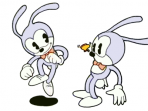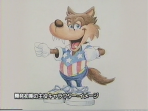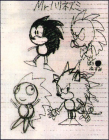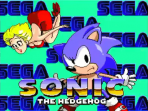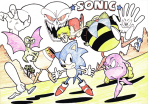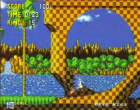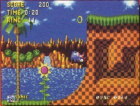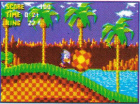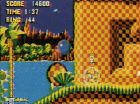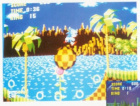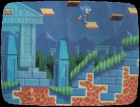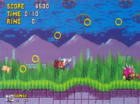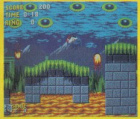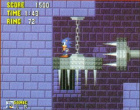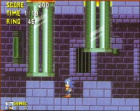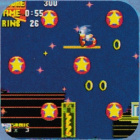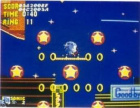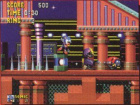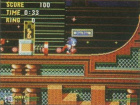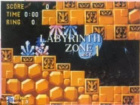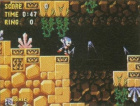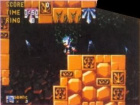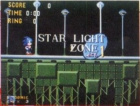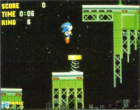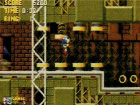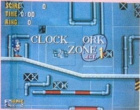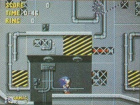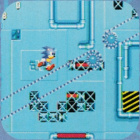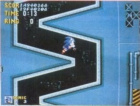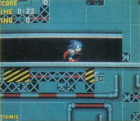Difference between revisions of "Sonic the Hedgehog (16-bit)/Development"
From Sonic Retro
m (→Other Concept Art) |
(The page has been given a shine from top to bottom. Roll on, Sonic.) |
||
| Line 1: | Line 1: | ||
| − | ''[[Sonic the Hedgehog (16-bit)|Sonic the Hedgehog]]'' | + | ''[[Sonic the Hedgehog (16-bit)|Sonic the Hedgehog]]'' went through many ideas and changes during the development process. What follows is a collection of items related to the game's development. |
==Development Process== | ==Development Process== | ||
| − | |||
| − | + | [[Image:Sonicguide4.jpg|thumb|190px|A collection of images of [[Sonic the Hedgehog]] drawn during the creation of the first game. From the [[Sonic the Hedgehog Material Collection]].]] | |
| − | [[Image: | + | Though [[sega:Sega|Sega]] had received marginal success with their first mainstream videogame console, the [[sega:Sega Master System|Sega Master System]], it was unable to compete with the Nintendo Entertainment System, the console that not only saved the videogame market in the United States but defined an entire generation of gamers. Wanting to become more than just a name known for arcade hits and become a major player in the gaming world, Sega released their entry into the 16-bit wars, the [[sega:Sega Mega Drive|Sega Mega Drive]] in October 1988 in Japan. Premiering in the United States the following January, the executives knew there was still an essential element missing from the equation that would push them beyond both the NES and its upcoming successor, the Super Nintendo. |
| − | + | ||
| + | Although Sega had a mascot in the form of [[sega:Alex Kidd|Alex Kidd]] during the Master System days, the franchise had never gained the momentum they had hoped for. Realizing the importance of having a strong, central franchise, Sega began an internal competition across all of its branches to create the company's answer to the Super Mario Bros. For months, numerous character designs were drawn up by an untold number of people, ranging from American wolves to overall-wearing chickens. In the end, it came down to the handful of drawings from a man named [[Naoto Ohshima]]. Having previously been involved in the design of the ''[[sega:Phantasy Star|Phantasy Star]]'' series, it was his entries that stood out the most. In various interviews that have described the story, there were four main designs that stood out: a gray rabbit, an armadillo, a round man with a large mustache, and a hedgehog character. It was the latter of these that would ultimately win the competition, and the world of [[Sonic the Hedgehog]] was soon to follow. | ||
| + | |||
| + | The character, originally called [[Mr. Needlemouse]], was from the get-go meant to be a reflection not only of Sega, but of the United States. At the time, it was believed that if a franchise was to become popular in the U.S., that it would automatically succeed in Japan as well. Using cues from such well-known American cartoons as Felix the Cat and Mickey Mouse, "Mr. Needlemouse" gradually morphed into "The Most Famous Hedgehog in the World." While the blue hue of the character was a reflection of the company's logo, it also drew inspiration from another famous American creation - Santa Claus. The red and white suit of Father Christmas was used as the basis for the red and white color scheme of Sonic's iconic footware, while the physical design (buckle included) was inspired by Michael Jackson, the biggest pop star of the 1980's. | ||
| + | |||
| + | Though Ohshima was responsible for the creation of the hedgehog, he was only one member of the 15-strong team of Sega's AM8 division. Reuniting with the programmer of ''Phantasy Star'', [[Yuji Naka]] became responsible for creating the game engine Sonic the Hedgehog would run through. Before the character of Sonic had won in the internal competition, the idea for the gameplay was of a character that would pick up items and throw them at enemies. This gameplay, partly inspired by the rabbit character, would have had him use his ears to pick up the items. However, using his own inspiration for his love of fast vehicles, Naka pushed the engine more and more, wanting the character to become faster. Realizing the entire mechanic of having to pick up items and throwing them slowed the entire experience, the idea came to have the character be the weapon, curling up and using his own momentum to destroy whatever enemies would come near. It was this change in plans that helped Sonic win the internal competition, and have himself poised to be Sega's first true superstar. | ||
| + | |||
| + | With a character and engine in place, it was the work of [[Hirokazu Yasuhara]] that would help bring the elements together. Director and Game Planner, he was the one ultimately responsible for making the various [[Zone|zones]] of ''Sonic the Hedgehog'' turn out the way they do in the final product. Along with a team of artists and sound engineers, AM8 decided to dub themselves "[[Sonic Team]]," a moniker that is still around to this very day. | ||
| + | |||
| + | [[Image:Sonicdebut.jpg|thumb|190px|The tour poster for [[DREAMS COME TRUE]] in 1990, officially unveiling Sonic the Hedgehog to the world.]] | ||
| + | Work on the game went underway in April of 1990, the mythology of Sonic and the locale of the game, [[South Island]], being worked on actively. The public at large would soon get a first glimpse at Sega's latest creation that same year, his image stamped on the 1990 tour of the highly-successful Japanese music group [[DREAMS COME TRUE]]. Wanting a unique soundtrack to the game, Sega hired [[Masato Nakamura]] to compose the legendary tracks that pepper the game. Being one of the driving forces behind DREAMS COME TRUE, it only made sense for Sega to sponsor the tour, using it as the first advertising push to a game that would not be seen in Japan until July of 1991. | ||
| + | |||
| + | Having over a year of development, ''Sonic the Hedgehog'' was hyped beyond belief, the development cycle being unusually long for a game of that era. All three branches of Sega realized the importance of the game, knowing it could make or break the system. Ohshima, knowing that a protagonist is only as good as the villain they fight, went back to one of the designs that had been discarded for the main character of the game, the mustached man, and worked on simplifying the design. Wanting to create an antagonist that was simple to draw for young kids, the character of [[Dr. Eggman]] was born. | ||
| + | |||
| + | Though developed entirely in Japan, the game would actually see release first in the west, premiering on U.S. shores on June 23, 1991. A few random bugs and effects would be polished for the Japan release, but it was with that game the 16-bit wars truly began. Drawing critical and commercial success in the west, ''Sonic the Hedgehog'' brought the character - and the company behind it - into the mind of the general public. | ||
| + | |||
| + | While there were originally intended to be ports to the [[Sonic the Hedgehog (Amiga)|Amiga]] and the [[Sonic the Hedgehog 1 CD|Mega CD]], it was decided that the game would remain on the Mega Drive for the time being, letting the cart become one of the main selling points for the system. | ||
| + | |||
| + | ==Westernization== | ||
| + | |||
| + | [[Image:STHPromoSTHPromoCover.jpg|thumb|190px|The westernized look of Sonic the Hedgehog, Dr. Eggman, and the Green Hill Zone. From the [[Sonic the Hedgehog (promotional comic)|American promotional comic]].]] | ||
| + | Although the game was a huge success, originally Sega of America was weary of the concept of Sonic as a character. Though hedgehogs were well known in Japan, at the time hardly anyone had even heard the word in the United States. As more information of the game was given to the offices in the U.S., it was decided that the marketing for the character would be modified from what the Japanese team was working on. Discarding the simplistic world of [[South Island]], a storyline was developed in which Sonic the Hedgehog was once a brown hedgehog that, through a chance meeting involving a kindly scientist, turned into the blue hedgehog featured in the game. That same scientist, [[Dr. Ovi Kintobor]], would be transformed into the villain of the piece due to an accident involving the [[Chaos Emeralds]] and his invention, the [[R.O.C.C.]] The physical designs of the characters Sonic and Eggman were also tweaked, making them look more like the style of 1980's cartoon phenomenons, and in the process trying to make Dr. Eggman look far more sinister than Ohshima's art suggested. This change in tone for the character was reflected further when it was decided that the given name of the character should be changed for western audiences. | ||
| + | |||
| + | Game tester and Sega help line employee [[Dean Sitton]] was the one responsible for coming up with many of the western names of the characters in the games, including such [[badniks]] as [[Buzzbomber]] and [[Ball Hog]]. However, his greatest contribution to the westernization of the franchise was coming up with the name Dr. Ivo Robotnik.[http://forums.sonicretro.org/index.php?showtopic=6657] | ||
| + | |||
| + | {{quote|The game Sonic game in in an early state (just a few levels and some of the characters appeared as garbage chars that flickered. The producer of the US version would be in Japan and call in for updates. Like how many rings for a free man...how many rings for a continue etc.. I got to play the game for a week or so and I submitted a document that showed the characters in the game that I could see and a few names for each of them. Dr. Badvibes and many other names were not chosen. | ||
| + | |||
| + | I named Ivo Robotnik, [[Ball Hog|Ballhog]], and 3-4 more from that game. I helped to flesh out the fiction for Greenhill and Sally/Sandy/Amy? whatever the girls name is now... with a guy named Jamie Wojik... usually producers of games have only to fill in the blanks..it doesn't always matter how the blanks get filled in.}} | ||
| + | |||
| + | While Robotnik was the final name for the character, Sitton had thrown a handful of other names that could have been used for the antagonist. | ||
| + | |||
| + | {{quote|as far as the change, its as if someone held up an object and said "what do you call this"? ... meaning I didn't create the object... I just named it. I found the list someone else asked about - other names that I suggested that were rejected. other robotnik names were, doctor X, Doctor Gloom, Dr. What.}} | ||
| + | |||
| + | [[Image:Toon eggman2.png|thumb|190px|A westernized version of Dr. Eggman, renamed Dr. Ivo Robotnik.]] | ||
| + | Also thrown about were the names "Dr. Badvibes," "Mister Badwrench," "Mr. Bad Year" and "Fatty Lobotnik." Even the first name, "Ivo," was suggested by Mr. Sitton, pronouncing the name with a soft "I," having it sound closer to the word "evil." | ||
| + | |||
| + | Although the changes weren't as dramatic as other Japanese properties have had over the years, the original Sonic Team was unhappy when they saw what Sega of America was doing to their work. Years later, Ohshima would go on record saying he was baffled as to why they felt the need to redraw his artwork and come up with concepts that had nothing to do with the game, especially as it had all been originally design with a western audience in mind. Even though they felt this way, there was nothing they could do to alter the course SOA was on. | ||
| + | |||
| + | The marketing of the game in the west was focused on the speed aspects of the game, at the same time making clear comparisons between the Mega Drive (called the Genesis in the United States) and the competition. Then-president of Sega of Japan, [[Hayao Nakayama]], was just as baffled by what SOA was planning on, being especially against the idea of making ''Sonic'' the bundled title with the system so early on in the software's life cycle. In the end, however, he allowed [[Tom Kalinske]] to have free reign, confident in the decision-making powers of the man he hired.[http://www.1up.com/features/essential-50-sonic] In the end, the gamble worked, and the aggressive marketing campaign helped showcase the game Sonic Team had crafted together. For the first time, Sega would be a contender, for a significant period even beating out Nintendo in terms of number of consoles sold in the west. | ||
| + | |||
| + | ==Concept Art== | ||
| + | |||
| + | ===Rejected Character Designs=== | ||
| + | The following is a collection of images drawn by a variety of people within Sega during the internal competition to come up with a new mascot for the company. Among the selection is the rabbit image, for which served as the original inspiration for the gameplay. While the throwing dynamic was removed from the final product, it was fleshed out for the 1995 Sega game ''[[sega:Ristar|Ristar]]'' which contained a handful of members that worked on some of the Sonic titles. The mechanic would eventually be put into ''[[Sonic Adventure]]'' and ''[[Sonic Adventure 2]]'', although it was only an afterthought that was not necessarily for any of the game. The concept was also echoed in the much-later character [[Cream the Rabbit]], who would "throw" her [[Chao]] at enemies in ''[[Sonic Advance 2]]''. Interestingly, the below gallery does not contain any images of the armadillo character, so it is unknown if those sketches served as the inspiration behind [[Mighty the Armadillo]]. | ||
<gallery widths="148px" heights="140px" perrow="4"> | <gallery widths="148px" heights="140px" perrow="4"> | ||
| + | Image:sonic1-rabbit.png|The Sonic-esque rabbit. | ||
Image:s1concept-WARRIOR.jpg|Warrior Design with two outfits. | Image:s1concept-WARRIOR.jpg|Warrior Design with two outfits. | ||
Image:s1concept-CLOWNNWOLFBOY.jpg|Clown and Warrior wearing head of a animal. | Image:s1concept-CLOWNNWOLFBOY.jpg|Clown and Warrior wearing head of a animal. | ||
| − | Image:s1concept-Human.jpg|Human character with Bart Simpson like hair | + | Image:s1concept-Human.jpg|Human character with Bart Simpson-like hair. |
| − | |||
Image:s1concept-WINDUPROBOTROOK.jpg|Robot character and two other characters. | Image:s1concept-WINDUPROBOTROOK.jpg|Robot character and two other characters. | ||
| − | |||
Image:s1concept-WEIRDCREATURE.jpg|Possibly a porcupine? | Image:s1concept-WEIRDCREATURE.jpg|Possibly a porcupine? | ||
Image:s1concept-Chick.jpg|Chicken with an attitude. | Image:s1concept-Chick.jpg|Chicken with an attitude. | ||
| Line 21: | Line 62: | ||
</gallery> | </gallery> | ||
| − | + | ===Sonic the Hedgehog/Dr. Eggman=== | |
| − | == | + | <gallery widths="148px" heights="140px" perrow="4"> |
| − | + | Image:s1concept-MRHEDGEHOG.jpg|An extremely early hedgehog design with more human-like features. | |
| + | Image:S1concept-Needlemouse.jpg|Sonic art, the text translates to "Mr. Hedgehog" or "[[Mr. Needlemouse]]." | ||
| + | Image:S1concept-HEDGEHOG.jpg|A color sketch of Sonic, moving closer to the finished product. | ||
| + | Image:s1concept-eggman.jpg|The initial drawing of what would become Dr. Eggman. [[:Image:S2 ElectronicGamingMonthly Issue45 April1993 Page46.jpg|This EGM article]] goes on about how he was one of the finalists as to who would be the protagonist in the game. | ||
| + | Image:S1concept-SCENE.jpg|Art of Dr. Eggman in an early form of the [[Eggpod]] where it seems to be powered with wings, all the while being chased by Sonic. | ||
| + | </gallery> | ||
| − | + | ===Madonna=== | |
| − | + | A concept that was toyed around with but ultimately dropped from the final product was the character Madonna. Intended to be a love interest for Sonic, it is unknown just how the dynamic between the two characters would have gone about. The concept art for the character was featured in the compilation title ''[[Sonic Gems Collection]]'', although artwork for the character had been on the Internet prior to the game's release. The idea of a hedgehog/human romance was eventually pursued in the game ''[[Sonic the Hedgehog (2006)]]'' with the character of [[Princess Elise]], with less than stellar results. | |
| − | |||
| − | |||
| − | |||
| − | |||
| − | |||
| − | |||
| − | |||
| − | |||
<gallery widths="148px" heights="140px" perrow="4"> | <gallery widths="148px" heights="140px" perrow="4"> | ||
Image:S1concept-Madonna.jpg|Sonic and Madonna. | Image:S1concept-Madonna.jpg|Sonic and Madonna. | ||
| − | Image:Sonic_Gems_300.jpg|Sonic, Madonna | + | Image:Sonic_Gems_300.jpg|Sonic, Madonna, and Eggman dressed in a bee outfit. Also pictured are various enemy concepts that were ultimately not used. |
| − | Image:SonicGems299.jpg | + | Image:SonicGems299.jpg |
</gallery> | </gallery> | ||
| − | ==Sound Test Band== | + | ===Sound Test Band=== |
| − | [[Image:Sonicband.jpg|right|thumb|220px|The Sonic Band | + | [[Image:Sonicband.jpg|right|thumb|220px|The Sonic the Hedgehog Band.]] |
| + | |||
| + | Another concept that was forced to be dropped was the idea of Sonic being the lead in a band. Though not meant to be a part of the gameplay, there was originally intended to be a full-fledged sound test within the game, complete with animated graphics of Sonic break-dancing to the music of the "Sonic the Hedgehog Band." [[Vector the Crocodile]], who would make his official introduction in the [[sega:Sega 32X|Sega 32X]] title ''[[Knuckles Chaotix|Chaotix]]'', was originally meant to be the keyboardist for this graphic. [[Sharps the Chicken]], [[Max the Monkey]], and [[Mach the Rabbit]] were to round out the cast playing the guitar, bass, and drums respectively. Due to time constraints, the concept had to be scrapped, a no-frills sound test becoming part of the hidden level select screen. The extra space designated for the graphics was given to the "SEGA" choir chime heard in the beginning of the game, which took up nearly an eighth of the cartridge space.[http://xbox.gamespy.com/articles/654/654750p5.html] With the exception of Vector, none of these characters have been used in a Sonic the Hedgehog game, although Sharps, Max, and Mach have recently surfaced in the pages of the [[Archie Comics|Archie]] comic ''[[Sonic the Hedgehog (Archie comics)|Sonic the Hedgehog]]''. | ||
| − | |||
| − | == | + | ===Level Concept Art=== |
| − | |||
<gallery widths="148px" heights="140px" perrow="4"> | <gallery widths="148px" heights="140px" perrow="4"> | ||
File:S1concept1.JPG|Text Translation: Metallic kind of stage... The background is styled like south-east Asia, golden country, (...) (are) gold colored plating. | File:S1concept1.JPG|Text Translation: Metallic kind of stage... The background is styled like south-east Asia, golden country, (...) (are) gold colored plating. | ||
| − | Image:S1concept-Loops.jpg|Alternate scan | + | Image:S1concept-Loops.jpg|Alternate scan of the stylized loop art not used in final. |
| − | File:S1concept2.JPG|Text Translation: CG styled stage... Blue skies and green(ery) are the basis, nothing till now, CG styled background | + | File:S1concept2.JPG|Concept art of a [[Green Hill Zone]]-esque area. Text Translation: CG styled stage... Blue skies and green(ery) are the basis, nothing till now, CG styled background |
File:S1concept3.JPG|Text Translation: Rocky mountain and underwater stage... Japanese styled rocky mountain stage, with underwater scene. In the map, spin (jump) and you can cross the water, but various techniques make it possible to (...) the course. | File:S1concept3.JPG|Text Translation: Rocky mountain and underwater stage... Japanese styled rocky mountain stage, with underwater scene. In the map, spin (jump) and you can cross the water, but various techniques make it possible to (...) the course. | ||
| − | Image:S1concept-WaterArt.jpg|Alternate | + | Image:S1concept-WaterArt.jpg|Alternate scan. |
| − | File:S1concept4.JPG|Text Translation: Stage where the land shakes... The underground has an amoeba shape and the ground shakes. The amoeba shaped terrain (...) with canals. Can also dive into the ground. | + | File:S1concept4.JPG|Concept art of a [[Marble Zone]]-esque area. Text Translation: Stage where the land shakes... The underground has an amoeba shape and the ground shakes. The amoeba shaped terrain (...) with canals. Can also dive into the ground. |
| − | Image:S1concept-MarbleZone.jpg|Alternate | + | Image:S1concept-MarbleZone.jpg|Alternate scan. |
File:S1concept5.JPG| | File:S1concept5.JPG| | ||
File:S1concept6.JPG| | File:S1concept6.JPG| | ||
File:S1concept7.JPG| | File:S1concept7.JPG| | ||
| − | Image:S1concept-TubeArt.jpg|Alternate | + | Image:S1concept-TubeArt.jpg|Alternate scan of previous two images. |
| − | File:S1concept8.JPG| | + | File:S1concept8.JPG|Concept art of a [[Scrap Brain Zone]]-esque area. |
| − | File:Sega Players Enjoy Club Sonic Concept art.jpg|Published in "SPEC" | + | File:Sega Players Enjoy Club Sonic Concept art.jpg|Published in "SPEC," this concept art shares similar features to the early Green Hill Zone mock-up screenshot found in this [[:File:GHZ-DarkBG.jpg|image]], including the trees in the foreground, the blocky area underneath the mountains, and even Sonic's pose. |
| − | |||
| − | |||
| − | |||
</gallery> | </gallery> | ||
| Line 73: | Line 108: | ||
===Portuguese Mega Drive Commercial=== | ===Portuguese Mega Drive Commercial=== | ||
[[Image:GHZ bossball.JPG|right|noframe|140px]] | [[Image:GHZ bossball.JPG|right|noframe|140px]] | ||
| − | A Portuguese Mega Drive commercial | + | A Portuguese Mega Drive commercial available at [http://www.sega-16.com/Video%20Commercial%20Archive.php Sega-16] shows a wrecking ball for the Green Hill Zone boss that has a sparkle which circles around it. |
====Translation of commercial==== | ====Translation of commercial==== | ||
| Line 88: | Line 123: | ||
===French Sonic Commercial=== | ===French Sonic Commercial=== | ||
[[Image:LZ Spring.JPG|right|noframe|140px]] | [[Image:LZ Spring.JPG|right|noframe|140px]] | ||
| − | [http://www.dailymotion.com/objectifsega/video/x3x23p_sonic-the-hedgehog-pub-fr_videogames This French commercial] | + | [http://www.dailymotion.com/objectifsega/video/x3x23p_sonic-the-hedgehog-pub-fr_videogames This French commercial] showcases an unseen behavior of the spring in Marble Zone, seemingly extra long when used, and when bumped into the two blocks behind it disappear. |
====Translation of commercial==== | ====Translation of commercial==== | ||
| Line 98: | Line 133: | ||
And you're gonna laugh, because you're not even at the half of the game.}} | And you're gonna laugh, because you're not even at the half of the game.}} | ||
| − | == | + | ===Consumer Electronics Show=== |
| − | === | + | [[File:GHZ-CES91-1.jpg|right|noframe|140px]] |
| + | [[File:GHZ-CES91-2.jpg|right|noframe|140px]] | ||
| + | [http://www.youtube.com/watch?v=L9H3edAcnZ4 These] [http://www.youtube.com/watch?v=2l4IPW6fkJw two] short clips uncovered by community member [[drx]] feature footage taken at the Consumer Electronics Show in March of 1991. Though compiled only three months before the game hit U.S. shores, the footage recorded features numerous differences even in the first level of the game. Among that which is noticeable are the flowers in the level being purple instead of green, the word "RING" instead of "RINGS" in the HUD, and the brief notice of an image of Eggman in a [[monitor]] flashing in an almost roulette-styled fashion, though it is unknown what the result of hitting the box would be. As the player doesn't jump onto it, whether there were meant to be item boxes that gave you random power-ups or if the programming for the monitors had yet to be finalized is unknown. There are also examples of an earlier Ball Hog enemy that attacks in a similar fashion to the [[Crabmeat|Crabmeats]] found in the final version of the Green Hill Zone, throwing a projectile on either side as opposed to the single shot they fire in the final version of the Scrap Brain Zone. Concept art for this variation of the Ball Hog can [[:File:Sonic1 jp manual 42 43.gif|be seen within]] the Japanese ''Sonic the Hedgehog'' manual. Also of note is that a form of the debug mode is active in the clips, the numbers in the lower right hand corner corresponding to debug values. The full video from which these clips are from can be viewed [http://www.archive.org/details/ces_2 here]. | ||
| + | |||
| + | ==Promotional Screenshots== | ||
| + | The following is a collection of images published in a variety of sources used to advertise ''Sonic the Hedgehog'' and to comment on its progress. Because of this, many of the images feature differences from the final product. | ||
| + | ===Title Screen=== | ||
<gallery widths="140px" heights="140px" perrow="4"> | <gallery widths="140px" heights="140px" perrow="4"> | ||
Image:S1TitleBlack.png|Titlescreen with a black background similar to the [[Sonic the Hedgehog (8-bit)|8-bit game]]. | Image:S1TitleBlack.png|Titlescreen with a black background similar to the [[Sonic the Hedgehog (8-bit)|8-bit game]]. | ||
Image:S1Title2.jpg|A near final title screen with "Press Start Button" text on-screen. | Image:S1Title2.jpg|A near final title screen with "Press Start Button" text on-screen. | ||
| − | |||
| − | |||
| − | |||
| − | |||
| − | |||
Image:S1StageSelect.jpg|An earlier level select. Final zone is not listed and Xs are listed after some levels. The "Press Start Button" text is visible once again. | Image:S1StageSelect.jpg|An earlier level select. Final zone is not listed and Xs are listed after some levels. The "Press Start Button" text is visible once again. | ||
</gallery> | </gallery> | ||
| Line 113: | Line 149: | ||
===Green Hill Zone=== | ===Green Hill Zone=== | ||
<gallery widths="140px" heights="140px" perrow="4"> | <gallery widths="140px" heights="140px" perrow="4"> | ||
| − | Image:GHZ-DarkBG.jpg| | + | Image:GHZ-DarkBG.jpg|An early Green Hill Zone screenshot featuring a city in the background. Trees and a brown rock (which is purple in the final game) can be seen in the foreground. Also of note are the missing HUD and life icons. Most likely a mock-up. |
| − | Image:GHZ-WelcomeSign.png|A Welcome Sign with Kanji underneath it. Again the city is visible. | + | Image:GHZ-WelcomeSign.png|A Welcome Sign with Kanji underneath it. Again the city is visible. Possibly another mock-up image. |
| − | Image:GHZ-loop.jpg|This screenshot is from | + | Image:GHZ-loop.jpg|This screenshot is from the build of ''Sonic 1'' playable at CES 1991. There are debug values in the bottom right of the screen and no life counter, and features the singular "RING" instead of "RINGS." The flowers are alsopurple instead of green (though in the final game they're purple in the cutscene after Final Zone). |
Image:GHZ-Debug.jpg|More of the old debug mode. The water in the background is the same color as the sky, similar to the final game's title screen. Sonic's position is represented differently by the debug mode in the final game. | Image:GHZ-Debug.jpg|More of the old debug mode. The water in the background is the same color as the sky, similar to the final game's title screen. Sonic's position is represented differently by the debug mode in the final game. | ||
Image:GHZ-PinkFlowers.jpg|This screenshot is from a later version, as [[Moto Bug]] badniks are present. The HUD still reads "RING" and the flowers are still purple. | Image:GHZ-PinkFlowers.jpg|This screenshot is from a later version, as [[Moto Bug]] badniks are present. The HUD still reads "RING" and the flowers are still purple. | ||
| − | Image:GHZ-Ball.jpg|A rolling ball. This can still be found in debug mode but is not placeable. The sprite was | + | Image:GHZ-Ball.jpg|A rolling ball. This can still be found in debug mode but is not placeable. The sprite was reused for the zone's boss. |
| − | Image:GHZ-Ball4.jpg| | + | Image:GHZ-Ball4.jpg|Sonic giving the rolling ball a push. |
| − | Image:GHZ-Ball2.jpg|The ball again. [[Sonic the Hedgehog: A New Superstar (Game Players Encyclopedia, 1991)| | + | Image:GHZ-Ball2.jpg|The ball again. The [[Sonic the Hedgehog: A New Superstar (Game Players Encyclopedia, 1991)|following article]] explains the ball, saying it can be pushed but can also kill the player. |
Image:GHZ-Ball3.JPG|The ball again, but this time it is in the air. | Image:GHZ-Ball3.JPG|The ball again, but this time it is in the air. | ||
| − | Image:GHZ-JumpPunch.jpg|Sonic punching the air after completing the act as an early end level celebration. The sprites, though unused in the final game, still exist within the ROM | + | Image:GHZ-JumpPunch.jpg|Sonic punching the air after completing the act as an early end level celebration. The sprites, though unused in the final game, still exist within the ROM. |
Image:GHZ-Monitor.jpg|This shield monitor is not here in final. | Image:GHZ-Monitor.jpg|This shield monitor is not here in final. | ||
Image:GHZ-Hurted.jpg|After being hit, Sonic gets knocked back more than in final. | Image:GHZ-Hurted.jpg|After being hit, Sonic gets knocked back more than in final. | ||
| − | |||
| − | |||
Image:GHZ-map.JPG|A prototype map, a rolling ball can be seen. | Image:GHZ-map.JPG|A prototype map, a rolling ball can be seen. | ||
File:GHZ map.png|Another prototype map. | File:GHZ map.png|Another prototype map. | ||
| Line 134: | Line 168: | ||
===Marble Zone=== | ===Marble Zone=== | ||
<gallery widths="140px" heights="140px" perrow="4"> | <gallery widths="140px" heights="140px" perrow="4"> | ||
| − | Image:MZ-Tiles.jpg|Strange level graphics and falling tiles which can be balanced on. | + | Image:MZ-Tiles.jpg|Strange level graphics and falling tiles which can be balanced on. Most likely another mock-up. |
| − | Image:MZ-UFO2.png|One of the main features of the prototype Marble Zone was the | + | Image:MZ-UFO2.png|One of the main features of the prototype Marble Zone was the existence of rotating UFOs in the background. All traces of these graphics are removed in the final game (though a single frame appeared in the [[Game Secrets:Sonic the Hedgehog Mobile|mobile phone port of Sonic 1]]). |
| − | + | Image:MZ-UFO.jpg|These [[Yadrin]] badniks don't appear in this level normally, but can be placed via debug mode. | |
| − | Image:MZ-UFO.jpg|These [[Yadrin]] badniks don't appear in this level normally, but can be placed via | ||
Image:MZ-UFOx.png|Same pic but in higher quality. | Image:MZ-UFOx.png|Same pic but in higher quality. | ||
| − | Image:MZ-UFODebug.jpg| | + | Image:MZ-UFODebug.jpg|Footage of the UFOs rotating can be seen in the film [http://www.youtube.com/watch?v=1z9mzA-Q828 Wayne's World] during a promotion for "Noah's Arcade." Also the lava in the bottom right is similar to that of the mock-up screenshot earlier. |
Image:MZ-UFO4.JPG|More UFOs. | Image:MZ-UFO4.JPG|More UFOs. | ||
File:MZ ufo again.png|More UFOs and Yadrin badnik. | File:MZ ufo again.png|More UFOs and Yadrin badnik. | ||
| Line 151: | Line 184: | ||
===Spring Yard Zone=== | ===Spring Yard Zone=== | ||
<gallery widths="140px" heights="140px" perrow="4"> | <gallery widths="140px" heights="140px" perrow="4"> | ||
| − | Image:SYZ-Sparkling.png| | + | Image:SYZ-Sparkling.png|Originally called "Sparkling Zone," this shot shows off the original background to the level. The sign behind the HUD says "good luck". |
Image:SYZ-Sparkling6.jpg|Same again. The sign on the right says "GOGO". | Image:SYZ-Sparkling6.jpg|Same again. The sign on the right says "GOGO". | ||
Image:SYZ-Sparkling9.JPG|At one point there was a giant set of rotating spikes in this area, most likely removed due to the difficulty of avoiding them. | Image:SYZ-Sparkling9.JPG|At one point there was a giant set of rotating spikes in this area, most likely removed due to the difficulty of avoiding them. | ||
| Line 160: | Line 193: | ||
Image:SYZ-Sparkling8.JPG|Strange sign with Kanji written on it. | Image:SYZ-Sparkling8.JPG|Strange sign with Kanji written on it. | ||
Image:SYZ-Sparkling9a.JPG|A "Good Luck" sign. | Image:SYZ-Sparkling9a.JPG|A "Good Luck" sign. | ||
| − | Image:SYZ-Sparkling3.jpg|More of the background | + | Image:SYZ-Sparkling3.jpg|More of the background. |
Image:SYZ-Fall.jpg|An unknown area, though judging from the time counter, it might be near the start of Act 2 or 3. A sparkle can be seen over the "good luck sign" indicating the sparkles moved around and weren't part of the background. | Image:SYZ-Fall.jpg|An unknown area, though judging from the time counter, it might be near the start of Act 2 or 3. A sparkle can be seen over the "good luck sign" indicating the sparkles moved around and weren't part of the background. | ||
| − | Image:SYZ-Sparkling4.jpg| | + | Image:SYZ-Sparkling4.jpg|A [[Moto Bug]] (found only in Green Hill Zone in the final game) and a purple [[Roller]] are present. |
Image:SYZ-Sparkling5.jpg|Sparkles are present. | Image:SYZ-Sparkling5.jpg|Sparkles are present. | ||
| − | File:SYZ A.png|A heavily edited screenshot | + | File:SYZ A.png|A heavily edited screenshot containing the signs found in this early build. |
File:SYZ B.png|Some odd ring placement. | File:SYZ B.png|Some odd ring placement. | ||
| − | File:SYZ C.png | + | File:SYZ C.png |
</gallery> | </gallery> | ||
| Line 173: | Line 206: | ||
Image:LZ-BlackBG.png|Labyrinth Zone once had a completely black background and was littered with different, smaller crystals. | Image:LZ-BlackBG.png|Labyrinth Zone once had a completely black background and was littered with different, smaller crystals. | ||
Image:LZ-BlueBG.jpg|This may be the underwater version of the black background. Sonic's palette is the same as above water. | Image:LZ-BlueBG.jpg|This may be the underwater version of the black background. Sonic's palette is the same as above water. | ||
| − | Image:LZ-NewBG3.jpg|The intro to | + | Image:LZ-NewBG3.jpg|The intro to Act 1, sporting a later "rocky" background. There is no water to be seen and the crystals are different. |
| − | Image:LZ-NewBG.png| | + | Image:LZ-NewBG.png|Water has yet to be placed on this slide. |
Image:LZ-NewBG2.jpg|More of the rocky background. In the final game this area has water and a spike on a chain, but it's largely empty here. | Image:LZ-NewBG2.jpg|More of the rocky background. In the final game this area has water and a spike on a chain, but it's largely empty here. | ||
Image:LZ-NewBG4.jpg|Even more of the rock background. The ceiling crystals were removed in the final game. | Image:LZ-NewBG4.jpg|Even more of the rock background. The ceiling crystals were removed in the final game. | ||
| − | File:LZ NewBG 5.png | + | File:LZ NewBG 5.png |
</gallery> | </gallery> | ||
| Line 184: | Line 217: | ||
Image:SLZ-Pic2.jpg|Star Light Act 1 has 3 rings missing from the start of the level. | Image:SLZ-Pic2.jpg|Star Light Act 1 has 3 rings missing from the start of the level. | ||
Image:SLZ-pic.JPG|This layout is different to the final game. | Image:SLZ-pic.JPG|This layout is different to the final game. | ||
| − | |||
Image:SLZ-Pic3.png|The top row of springs here are missing in final. | Image:SLZ-Pic3.png|The top row of springs here are missing in final. | ||
File:SLZ Pic 4.png|Debug mode appears to be active. | File:SLZ Pic 4.png|Debug mode appears to be active. | ||
| Line 193: | Line 225: | ||
===Scrap Brain Zone=== | ===Scrap Brain Zone=== | ||
<gallery widths="140px" heights="140px" perrow="4"> | <gallery widths="140px" heights="140px" perrow="4"> | ||
| − | Image:ClockOrkTitle.jpg| | + | Image:ClockOrkTitle.jpg|Originally known as the "Clockwork Zone," the title card at the beginning of the zone displays erroneously as "Clock ork Zone" due to the lack of a "W" character in the font used. |
Image:SBZ-Pic5.jpg|At this stage in development the level appears to be very short and unfinished. There are no rings, the background is identical to the foreground, and there are many similar screenshots of scrapped areas. | Image:SBZ-Pic5.jpg|At this stage in development the level appears to be very short and unfinished. There are no rings, the background is identical to the foreground, and there are many similar screenshots of scrapped areas. | ||
Image:SBZ-Pic3.jpg|...such as this. This area isn't in the final game and may just be here for demonstration purposes. In the top right you can see... | Image:SBZ-Pic3.jpg|...such as this. This area isn't in the final game and may just be here for demonstration purposes. In the top right you can see... | ||
| − | Image:SBZ-Pic1.png|...diagonal conveyor belts. Though horizontal ones made it to the final game, the diagonal ones | + | Image:SBZ-Pic1.png|...diagonal conveyor belts. Though horizontal ones made it to the final game, the diagonal ones are absent. |
File:SBZPic7.png|Diagonal belts again. The closest to these in the final game are conveyors with spinning platforms. | File:SBZPic7.png|Diagonal belts again. The closest to these in the final game are conveyors with spinning platforms. | ||
| − | Image:SBZ-Pic4.png|More of the different layout. | + | Image:SBZ-Pic4.png|More of the different layout. Most prominent is the similar image for the background and foreground, making them blend into each other. |
| − | Image:SBZ-Pic2.jpg|A zig-zag tunnel with debug mode enabled | + | Image:SBZ-Pic2.jpg|A zig-zag tunnel with debug mode enabled. |
Image:SBZ-Pic6.JPG|Different layout again. Sonic emerges from a speed tunnel. | Image:SBZ-Pic6.JPG|Different layout again. Sonic emerges from a speed tunnel. | ||
File:SBZ Pic 8.png|2 minutes and 6 seconds down the line and Sonic has yet to receive any points or rings. Also the background does not appear to be scrolling that much (if at all). | File:SBZ Pic 8.png|2 minutes and 6 seconds down the line and Sonic has yet to receive any points or rings. Also the background does not appear to be scrolling that much (if at all). | ||
</gallery> | </gallery> | ||
| + | |||
| + | ===Special Stage=== | ||
| + | <gallery widths="140px" heights="140px" perrow="4"> | ||
| + | Image:S1SpecialStage.png|A special stage level with a layout not seen in the final game. | ||
| + | Image:S1SpecialStage2.JPG|More of the different layout. | ||
| + | Image:S1SpecialStage3.JPG|...and again... | ||
| + | File:S1SpecialStage4.png|...and again... | ||
| + | File:S1SpecialStage5.png|...and again. | ||
| + | </gallery> | ||
| + | |||
| + | ==External Links== | ||
| + | *[http://www.youtube.com/watch?v=6D9h-4vQUHM Sonic the Hedgehog Retrospective] - The first of a four-part documentary covering the history of Sonic the Hedgehog, featuring interviews from the many key players behind the creation of the character and subsequent game. | ||
{{S1MDOmni}} | {{S1MDOmni}} | ||
[[Category:Game Development|Sonic the Hedgehog (16-bit)]] | [[Category:Game Development|Sonic the Hedgehog (16-bit)]] | ||
Revision as of 04:35, 19 March 2011
Sonic the Hedgehog went through many ideas and changes during the development process. What follows is a collection of items related to the game's development.
Contents
Development Process
Though Sega had received marginal success with their first mainstream videogame console, the Sega Master System, it was unable to compete with the Nintendo Entertainment System, the console that not only saved the videogame market in the United States but defined an entire generation of gamers. Wanting to become more than just a name known for arcade hits and become a major player in the gaming world, Sega released their entry into the 16-bit wars, the Sega Mega Drive in October 1988 in Japan. Premiering in the United States the following January, the executives knew there was still an essential element missing from the equation that would push them beyond both the NES and its upcoming successor, the Super Nintendo.
Although Sega had a mascot in the form of Alex Kidd during the Master System days, the franchise had never gained the momentum they had hoped for. Realizing the importance of having a strong, central franchise, Sega began an internal competition across all of its branches to create the company's answer to the Super Mario Bros. For months, numerous character designs were drawn up by an untold number of people, ranging from American wolves to overall-wearing chickens. In the end, it came down to the handful of drawings from a man named Naoto Ohshima. Having previously been involved in the design of the Phantasy Star series, it was his entries that stood out the most. In various interviews that have described the story, there were four main designs that stood out: a gray rabbit, an armadillo, a round man with a large mustache, and a hedgehog character. It was the latter of these that would ultimately win the competition, and the world of Sonic the Hedgehog was soon to follow.
The character, originally called Mr. Needlemouse, was from the get-go meant to be a reflection not only of Sega, but of the United States. At the time, it was believed that if a franchise was to become popular in the U.S., that it would automatically succeed in Japan as well. Using cues from such well-known American cartoons as Felix the Cat and Mickey Mouse, "Mr. Needlemouse" gradually morphed into "The Most Famous Hedgehog in the World." While the blue hue of the character was a reflection of the company's logo, it also drew inspiration from another famous American creation - Santa Claus. The red and white suit of Father Christmas was used as the basis for the red and white color scheme of Sonic's iconic footware, while the physical design (buckle included) was inspired by Michael Jackson, the biggest pop star of the 1980's.
Though Ohshima was responsible for the creation of the hedgehog, he was only one member of the 15-strong team of Sega's AM8 division. Reuniting with the programmer of Phantasy Star, Yuji Naka became responsible for creating the game engine Sonic the Hedgehog would run through. Before the character of Sonic had won in the internal competition, the idea for the gameplay was of a character that would pick up items and throw them at enemies. This gameplay, partly inspired by the rabbit character, would have had him use his ears to pick up the items. However, using his own inspiration for his love of fast vehicles, Naka pushed the engine more and more, wanting the character to become faster. Realizing the entire mechanic of having to pick up items and throwing them slowed the entire experience, the idea came to have the character be the weapon, curling up and using his own momentum to destroy whatever enemies would come near. It was this change in plans that helped Sonic win the internal competition, and have himself poised to be Sega's first true superstar.
With a character and engine in place, it was the work of Hirokazu Yasuhara that would help bring the elements together. Director and Game Planner, he was the one ultimately responsible for making the various zones of Sonic the Hedgehog turn out the way they do in the final product. Along with a team of artists and sound engineers, AM8 decided to dub themselves "Sonic Team," a moniker that is still around to this very day.
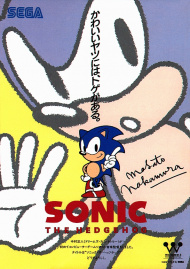
Work on the game went underway in April of 1990, the mythology of Sonic and the locale of the game, South Island, being worked on actively. The public at large would soon get a first glimpse at Sega's latest creation that same year, his image stamped on the 1990 tour of the highly-successful Japanese music group DREAMS COME TRUE. Wanting a unique soundtrack to the game, Sega hired Masato Nakamura to compose the legendary tracks that pepper the game. Being one of the driving forces behind DREAMS COME TRUE, it only made sense for Sega to sponsor the tour, using it as the first advertising push to a game that would not be seen in Japan until July of 1991.
Having over a year of development, Sonic the Hedgehog was hyped beyond belief, the development cycle being unusually long for a game of that era. All three branches of Sega realized the importance of the game, knowing it could make or break the system. Ohshima, knowing that a protagonist is only as good as the villain they fight, went back to one of the designs that had been discarded for the main character of the game, the mustached man, and worked on simplifying the design. Wanting to create an antagonist that was simple to draw for young kids, the character of Dr. Eggman was born.
Though developed entirely in Japan, the game would actually see release first in the west, premiering on U.S. shores on June 23, 1991. A few random bugs and effects would be polished for the Japan release, but it was with that game the 16-bit wars truly began. Drawing critical and commercial success in the west, Sonic the Hedgehog brought the character - and the company behind it - into the mind of the general public.
While there were originally intended to be ports to the Amiga and the Mega CD, it was decided that the game would remain on the Mega Drive for the time being, letting the cart become one of the main selling points for the system.
Westernization
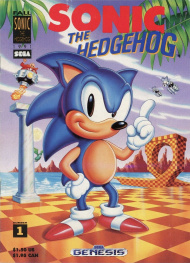
Although the game was a huge success, originally Sega of America was weary of the concept of Sonic as a character. Though hedgehogs were well known in Japan, at the time hardly anyone had even heard the word in the United States. As more information of the game was given to the offices in the U.S., it was decided that the marketing for the character would be modified from what the Japanese team was working on. Discarding the simplistic world of South Island, a storyline was developed in which Sonic the Hedgehog was once a brown hedgehog that, through a chance meeting involving a kindly scientist, turned into the blue hedgehog featured in the game. That same scientist, Dr. Ovi Kintobor, would be transformed into the villain of the piece due to an accident involving the Chaos Emeralds and his invention, the R.O.C.C. The physical designs of the characters Sonic and Eggman were also tweaked, making them look more like the style of 1980's cartoon phenomenons, and in the process trying to make Dr. Eggman look far more sinister than Ohshima's art suggested. This change in tone for the character was reflected further when it was decided that the given name of the character should be changed for western audiences.
Game tester and Sega help line employee Dean Sitton was the one responsible for coming up with many of the western names of the characters in the games, including such badniks as Buzzbomber and Ball Hog. However, his greatest contribution to the westernization of the franchise was coming up with the name Dr. Ivo Robotnik.[1]
| “ | The game Sonic game in in an early state (just a few levels and some of the characters appeared as garbage chars that flickered. The producer of the US version would be in Japan and call in for updates. Like how many rings for a free man...how many rings for a continue etc.. I got to play the game for a week or so and I submitted a document that showed the characters in the game that I could see and a few names for each of them. Dr. Badvibes and many other names were not chosen.
I named Ivo Robotnik, Ballhog, and 3-4 more from that game. I helped to flesh out the fiction for Greenhill and Sally/Sandy/Amy? whatever the girls name is now... with a guy named Jamie Wojik... usually producers of games have only to fill in the blanks..it doesn't always matter how the blanks get filled in. |
„ |
While Robotnik was the final name for the character, Sitton had thrown a handful of other names that could have been used for the antagonist.
| “ | as far as the change, its as if someone held up an object and said "what do you call this"? ... meaning I didn't create the object... I just named it. I found the list someone else asked about - other names that I suggested that were rejected. other robotnik names were, doctor X, Doctor Gloom, Dr. What. | „ |
Also thrown about were the names "Dr. Badvibes," "Mister Badwrench," "Mr. Bad Year" and "Fatty Lobotnik." Even the first name, "Ivo," was suggested by Mr. Sitton, pronouncing the name with a soft "I," having it sound closer to the word "evil."
Although the changes weren't as dramatic as other Japanese properties have had over the years, the original Sonic Team was unhappy when they saw what Sega of America was doing to their work. Years later, Ohshima would go on record saying he was baffled as to why they felt the need to redraw his artwork and come up with concepts that had nothing to do with the game, especially as it had all been originally design with a western audience in mind. Even though they felt this way, there was nothing they could do to alter the course SOA was on.
The marketing of the game in the west was focused on the speed aspects of the game, at the same time making clear comparisons between the Mega Drive (called the Genesis in the United States) and the competition. Then-president of Sega of Japan, Hayao Nakayama, was just as baffled by what SOA was planning on, being especially against the idea of making Sonic the bundled title with the system so early on in the software's life cycle. In the end, however, he allowed Tom Kalinske to have free reign, confident in the decision-making powers of the man he hired.[2] In the end, the gamble worked, and the aggressive marketing campaign helped showcase the game Sonic Team had crafted together. For the first time, Sega would be a contender, for a significant period even beating out Nintendo in terms of number of consoles sold in the west.
Concept Art
Rejected Character Designs
The following is a collection of images drawn by a variety of people within Sega during the internal competition to come up with a new mascot for the company. Among the selection is the rabbit image, for which served as the original inspiration for the gameplay. While the throwing dynamic was removed from the final product, it was fleshed out for the 1995 Sega game Ristar which contained a handful of members that worked on some of the Sonic titles. The mechanic would eventually be put into Sonic Adventure and Sonic Adventure 2, although it was only an afterthought that was not necessarily for any of the game. The concept was also echoed in the much-later character Cream the Rabbit, who would "throw" her Chao at enemies in Sonic Advance 2. Interestingly, the below gallery does not contain any images of the armadillo character, so it is unknown if those sketches served as the inspiration behind Mighty the Armadillo.
- S1concept-WARRIOR.jpg
Warrior Design with two outfits.
- S1concept-CLOWNNWOLFBOY.jpg
Clown and Warrior wearing head of a animal.
- S1concept-Human.jpg
Human character with Bart Simpson-like hair.
- S1concept-WINDUPROBOTROOK.jpg
Robot character and two other characters.
- S1concept-WEIRDCREATURE.jpg
Possibly a porcupine?
- S1concept-Chick.jpg
Chicken with an attitude.
Sonic the Hedgehog/Dr. Eggman
- S1concept-MRHEDGEHOG.jpg
An extremely early hedgehog design with more human-like features.
Sonic art, the text translates to "Mr. Hedgehog" or "Mr. Needlemouse."
- S1concept-HEDGEHOG.jpg
A color sketch of Sonic, moving closer to the finished product.
- S1concept-eggman.jpg
The initial drawing of what would become Dr. Eggman. This EGM article goes on about how he was one of the finalists as to who would be the protagonist in the game.
- S1concept-SCENE.jpg
Art of Dr. Eggman in an early form of the Eggpod where it seems to be powered with wings, all the while being chased by Sonic.
Madonna
A concept that was toyed around with but ultimately dropped from the final product was the character Madonna. Intended to be a love interest for Sonic, it is unknown just how the dynamic between the two characters would have gone about. The concept art for the character was featured in the compilation title Sonic Gems Collection, although artwork for the character had been on the Internet prior to the game's release. The idea of a hedgehog/human romance was eventually pursued in the game Sonic the Hedgehog (2006) with the character of Princess Elise, with less than stellar results.
Sound Test Band
Another concept that was forced to be dropped was the idea of Sonic being the lead in a band. Though not meant to be a part of the gameplay, there was originally intended to be a full-fledged sound test within the game, complete with animated graphics of Sonic break-dancing to the music of the "Sonic the Hedgehog Band." Vector the Crocodile, who would make his official introduction in the Sega 32X title Chaotix, was originally meant to be the keyboardist for this graphic. Sharps the Chicken, Max the Monkey, and Mach the Rabbit were to round out the cast playing the guitar, bass, and drums respectively. Due to time constraints, the concept had to be scrapped, a no-frills sound test becoming part of the hidden level select screen. The extra space designated for the graphics was given to the "SEGA" choir chime heard in the beginning of the game, which took up nearly an eighth of the cartridge space.[3] With the exception of Vector, none of these characters have been used in a Sonic the Hedgehog game, although Sharps, Max, and Mach have recently surfaced in the pages of the Archie comic Sonic the Hedgehog.
Level Concept Art
- S1concept1.JPG
Text Translation: Metallic kind of stage... The background is styled like south-east Asia, golden country, (...) (are) gold colored plating.
- S1concept2.JPG
Concept art of a Green Hill Zone-esque area. Text Translation: CG styled stage... Blue skies and green(ery) are the basis, nothing till now, CG styled background
- S1concept3.JPG
Text Translation: Rocky mountain and underwater stage... Japanese styled rocky mountain stage, with underwater scene. In the map, spin (jump) and you can cross the water, but various techniques make it possible to (...) the course.
- S1concept4.JPG
Concept art of a Marble Zone-esque area. Text Translation: Stage where the land shakes... The underground has an amoeba shape and the ground shakes. The amoeba shaped terrain (...) with canals. Can also dive into the ground.
- S1concept5.JPG
- S1concept6.JPG
- S1concept7.JPG
- S1concept8.JPG
Concept art of a Scrap Brain Zone-esque area.
Published in "SPEC," this concept art shares similar features to the early Green Hill Zone mock-up screenshot found in this image, including the trees in the foreground, the blocky area underneath the mountains, and even Sonic's pose.
Early Videos
Portuguese Mega Drive Commercial
A Portuguese Mega Drive commercial available at Sega-16 shows a wrecking ball for the Green Hill Zone boss that has a sparkle which circles around it.
Translation of commercial
| “ | Mega Drive by Sega. Infernal Machine. |
„ |
French Sonic Commercial
This French commercial showcases an unseen behavior of the spring in Marble Zone, seemingly extra long when used, and when bumped into the two blocks behind it disappear.
Translation of commercial
| “ | Well... are you angry? It's me, master Sega. So you're choosing Sonic. Let's go. |
„ |
Consumer Electronics Show
These two short clips uncovered by community member drx feature footage taken at the Consumer Electronics Show in March of 1991. Though compiled only three months before the game hit U.S. shores, the footage recorded features numerous differences even in the first level of the game. Among that which is noticeable are the flowers in the level being purple instead of green, the word "RING" instead of "RINGS" in the HUD, and the brief notice of an image of Eggman in a monitor flashing in an almost roulette-styled fashion, though it is unknown what the result of hitting the box would be. As the player doesn't jump onto it, whether there were meant to be item boxes that gave you random power-ups or if the programming for the monitors had yet to be finalized is unknown. There are also examples of an earlier Ball Hog enemy that attacks in a similar fashion to the Crabmeats found in the final version of the Green Hill Zone, throwing a projectile on either side as opposed to the single shot they fire in the final version of the Scrap Brain Zone. Concept art for this variation of the Ball Hog can be seen within the Japanese Sonic the Hedgehog manual. Also of note is that a form of the debug mode is active in the clips, the numbers in the lower right hand corner corresponding to debug values. The full video from which these clips are from can be viewed here.
Promotional Screenshots
The following is a collection of images published in a variety of sources used to advertise Sonic the Hedgehog and to comment on its progress. Because of this, many of the images feature differences from the final product.
Title Screen
Titlescreen with a black background similar to the 8-bit game.
Green Hill Zone
This screenshot is from the build of Sonic 1 playable at CES 1991. There are debug values in the bottom right of the screen and no life counter, and features the singular "RING" instead of "RINGS." The flowers are alsopurple instead of green (though in the final game they're purple in the cutscene after Final Zone).
This screenshot is from a later version, as Moto Bug badniks are present. The HUD still reads "RING" and the flowers are still purple.
The ball again. The following article explains the ball, saying it can be pushed but can also kill the player.
Marble Zone
One of the main features of the prototype Marble Zone was the existence of rotating UFOs in the background. All traces of these graphics are removed in the final game (though a single frame appeared in the mobile phone port of Sonic 1).
- MZ-UFO.jpg
These Yadrin badniks don't appear in this level normally, but can be placed via debug mode.
Footage of the UFOs rotating can be seen in the film Wayne's World during a promotion for "Noah's Arcade." Also the lava in the bottom right is similar to that of the mock-up screenshot earlier.
Spring Yard Zone
- SYZ-Sparkling2.png
Sparkles are present.
- SYZ-Sparkling9a.JPG
A "Good Luck" sign.
Labyrinth Zone
Star Light Zone
Scrap Brain Zone
Special Stage
- S1SpecialStage3.JPG
...and again...
External Links
- Sonic the Hedgehog Retrospective - The first of a four-part documentary covering the history of Sonic the Hedgehog, featuring interviews from the many key players behind the creation of the character and subsequent game.
| Sonic the Hedgehog (16-bit) | |
|---|---|
|
Main page (Gen|2013|3D|Ages) Manuals Development |
show;hide
Scrapped Enemies: |

